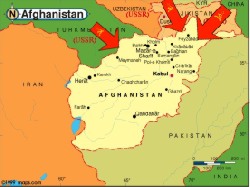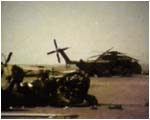
Page 3
1.3: Washington to Moscow
In the capitals of the two great Superpowers each now was faced with two major crises. The Soviet Union watched with horror as it became clear that the new Polish regime, while probably not capitalist, was at least anti-Soviet. However, the Soviet Union feared the difficulties it would cause to take action at this point. After all, they were preparing to invade Afghanistan on Christmas. President Carter, already under fire for his handling of the Iranian hostage situation now faced further ire from his domestic critics for not taking immediate action to exploit the Soviet problem.
1.4: No Peace at ChristmasDespite their concerns about Western reaction STAVKA began to prepare for an invasion designed to topple the new Polish Government. It would be simpler than many such operations given that there were Soviet air and land units scattered within Poland itself.
On Christmas day the Soviet Union invaded Afghanistan. That afternoon the National Security Council met in Washington, to discuss the world situation. The discussions (still classified to this very day in exact content) eventually resulted in a shaky consensus among the members. The United States should send the Soviet Union a note threatening to formally recognize the Government of Poland if the Soviets did not cease their invasion. Further at the meeting many recommended taking some action against Iran, immediately. Presented with the options President Carter declined to threaten the Soviet Union with the recognition of Poland. He did however agree that the Senate should withdraw SALT II from consideration and he relented on the issue of Iran. Opinion polls showed that the public's opinion of Carter was at an all-time low. Most overseas leader held a lower opinion of Carter's leadership that the US public did.
Fig. 3. Soviet Invasion of Afghanistan1.5: Operation Desert HawkCarter met throughout the day with his advisors. Finally some time early Boxing Day Carter made up his mind. His political advisors told him flat out that if he didn't do something soon, he'd lose the election in November. Carter decided to take decisive action.
Sadly Carter's idea of 'decisive' was less than so. US planners recommended a variety of concepts, but were almost universally in favor of a series of Air Strikes to cripple the Iranian military infrastructure combined with a raid to grab the hostages. Carter rejected all of the proposed options. Carter hated the idea of a massive crippling strike on Iran, one which would surely kill many civilians. He insisted on a precision Commando raid.
It was a total disaster. The US lacked the men to conduct such an operation with any real precision. Support would be needed, support that Carter was unwilling to allow. To make a bad situation worse one of the man in on the planning, Ranger Captain Mike Simpson (Mohammed Shiraz) had been converted to Islam and was passing information on to the Iranian fanatics. Through him complete plans for the raid fell into Iranian hands.
On January 4th elements of the Second Ranger Battalion were dropped into the Iranian desert to set up a base camp from which the assault would be staged and the prisoners would be extracted. Among the first men on the ground was Mike Simpson. The Iranian Air Force, aware of this, waited. On the evening of the 4th-5th the rest of the Rangers and their UH-1 Transport helicopters arrived. The raid was set to hit the compound near Tehran on the 5th shortly after 1PM. The raid turned into a fiasco beyond imagination. First of all 21 Rangers and 9 Air Force personal were killed when a Huey and C-130 collided during the night. However, with excellent logistics work things were sorted out and the helicopters departed for the attack on time at 12:15.
At about 12:30PM the Iranian Air Force arrived. They attempted two tasks, first to intercept the helicopters, at this they were not terribly successful, with the highly trained American pilots moving fast at low level. Their second task was to attack the American camp, at this they were successful. The C-130's to pick up the Americans had already begun to arrive and two of them were destroyed on the ground. The remainder of the camp suffered heavy rocket and bomb attack, so heavy indeed that when the Iranian Army arrived a few hours later only 52 Americans were still alive. By 3PM all of the American Helicopters had been forced down by lack of fuel (or enemy fire). The Rangers, true bearers of the American military spirit formed LGOP's (little groups of Paratroops) and set out to do as much damage as possible.
Fig. 5. The Aftermath1.6: The Politburo DecidesNews of the failure of the raid (and the deaths of 427 American soldiers) horrified the American people to no end and shook their confidence to the very core. Decisive action was demanded. The military advisors, despite their 'see-I-told-you-so' attitude which Carter, whose failure weighed heavily on him, found nearly unbearable were brought back in. This time they began to talk massive maneuvers and firepower. Looking from the White House onto a world whose future depended much on him, looking on the streets at the Americans whose lives depended on him, Jimmy Carter, President of the United States realized that he was in a world of shit.
1.7: The White House DecidesWitnessing, with much glee, the American failure in Iran and hearing from the KGB that the new American operation there was going to take up most of their available resources the Politburo, under Lenoid Brezenev let out a collective laugh. With the success of the Afghanistan operation and the American failure a window of opportunity had been opened for firm action in Poland. Two tank armies from Belarus were ordered forward into Poland to suppress the 'counter-revolution.' Some suggested that it would be quicker to use the forces in place in Poland and the GDR, but it was pointed out that, "in the event the situation gets out of hand those armies will be in position to put our western contingencies into action." February 1st was set as the date of commencement for the Soviet operation.
After much consultation with the Joint Chiefs of Staff and the Service Chiefs, as well as congressional leadership President Carter authorized the United States Armed forces to conduct Operation Central Run. The Operation called for massive air strikes on the Iranian Military combined with two land Operations. First the diversionary seizure of Bandar Abbas by the 1st Marine Brigade followed by a Divisional Strength landing by the 82nd Airborne Division at Shiraz where the American prisoners were now being held. Even with the forces already in place in the Persian Gulf it would be a large undertaking. Parts of the US Navy's reserve of Sealift ships was ordered to active duty. It was a terribly overt, but necessary move. February 1st was set as the date of commencement for the US operation.
NEXT WEEK: Chapter 2 - Invasion!
© 2000 Adam Yoshida. All Rights Reserved.



